As 2020 draws to a close, NASA is celebrating the Hubble Space Telescope’s 30 years of service by releasing 30 newly processed images of galaxies, star clusters and nebulae from the Caldwell catalogue, compiled by Sir Patrick Moore, a collection of 109 amateur-accessible targets not included in Charles Messier’s familiar list. Over Hubble’s three decades in space, starting with launch in April 1990, astronomers have observed 98 of the objects on the Caldwell list and the updated catalogue now includes processed images of 87 (several targets were imaged more than once). The new composite image below is a closeup of Caldwell 45, or NGC 5248, a beautiful spiral galaxy in the constellation Boötes, that was captured by Hubble’s Wide Field Camera 3 and Wide Field and Planetary Camera 2 in visible, infrared and ultraviolet light. The glowing red clouds indicate regions where new stars are lighting up.




